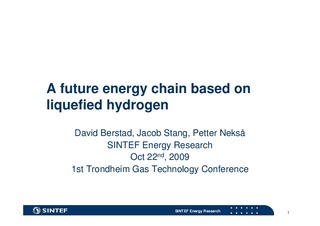| dc.contributor.author | Berstad, David Olsson | |
| dc.contributor.author | Stang, Hans Georg Jacob | |
| dc.contributor.author | Nekså, Petter | |
| dc.date.accessioned | 2017-07-06T13:31:16Z | |
| dc.date.available | 2017-07-06T13:31:16Z | |
| dc.date.created | 2015-09-24T20:06:31Z | |
| dc.date.issued | 2009 | |
| dc.identifier.citation | 1st Trondheim Gas Technology Conference | nb_NO |
| dc.identifier.uri | http://hdl.handle.net/11250/2448111 | |
| dc.description.abstract | In the efforts to curb emissions of greenhouse gases and local pollution hydrogen has the potential of becoming a prominent energy carrier in the future energy supply, for both automotive and stationary use. Today hydrogen is primarily consumed as chemical raw material in industries and in a smaller scale as energy carrier for transportation. In an envisioned transition of the use of hydrogen, from current patterns of use to becoming a widely consumed energy commodity, plant sizes are likely to increase considerably, possibly to a 10:1 scale, and result in a greater emphasis on energy efficiency due to shift in cost structures. From an end-user and societal perspective, prerequisites for the viability of the hydrogen energy chain are for instance user- customisation, safety and competitive retail prices. To obtain the latter, the sum of capital and operational costs must be minimised and hence a crucial element remains keeping the energy efficiency high by reducing the parasitic energy consumption throughout the chain. This applies to all parts: conversion from primary energy sources; conditioning and purification; storage; distribution; and end use. A significant challenge in the promotion of hydrogen as an energy carrier is hence to demonstrate reduced cost and high energy efficiency throughout the chain. Kramer et al. [1] have performed a comprehensive study on a large-scale hydrogen-based energy supply chain for automotive use. As pipeline infrastructure is deemed to be an unlikely option in the early stages of an infrastructure expansion, bulk transportation of hydrogen by trucks from the production site to filling stations is the likely option. The study concludes that in terms of cost, a chain with central production and distribution of liquefied hydrogen (LH2) is competitive with that of compressed gas (CGH2). Another significant benefit of distributing hydrogen in liquid form is the flexibility this offers for the retail-side delivery. As liquid can be | nb_NO |
| dc.description.abstract | A future energy chain based on liquefied hydrogen | nb_NO |
| dc.language.iso | eng | nb_NO |
| dc.rights | Navngivelse-Ikkekommersiell 4.0 Internasjonal | * |
| dc.rights.uri | http://creativecommons.org/licenses/by-nc/4.0/deed.no | * |
| dc.title | A future energy chain based on liquefied hydrogen | nb_NO |
| dc.title.alternative | A future energy chain based on liquefied hydrogen | nb_NO |
| dc.type | Lecture | nb_NO |
| dc.rights.holder | SINTEF Energi AS | nb_NO |
| dc.identifier.cristin | 1271806 | |
| cristin.unitcode | 7548,60,0,0 | |
| cristin.unitcode | 7548,70,0,0 | |
| cristin.unitcode | 7548,40,0,0 | |
| cristin.unitname | Gassteknologi | |
| cristin.unitname | Termisk energi | |
| cristin.unitname | Energibruk | |
| cristin.ispublished | true | |
| cristin.fulltext | postprint | |

